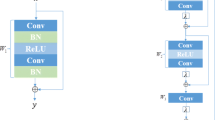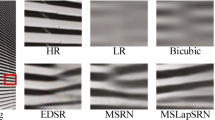Abstract
Recently, the image super-resolution (SR) methods based on residual learning have obtained remarkable quality performance. However, the current residual-learning methods have low computational performance and slow convergence rate. In this paper, we propose a high-efficiency two-level residual network to make the network learn more useful high-frequency information. Only 5 convolution layers in the LR space are used in our residual network, and no parameters are introduced in the other layers. Compared with the long training time up to several hours or days of previous deep residual networks, our simplified network can make the training time reduce to half an hour. Besides, our simplified network achieves satisfactory quality performance. The evaluation on the public datasets shows that our method can process SR of ultra-high definition (UHD) videos in real-time (more than 24 frames per second) on a generic graphical processing unit (GPU).






Similar content being viewed by others
References
Chang H, Yeung DY, Xiong Y (2004) Super-resolution through neighbor embedding. In: IEEE Conference on Computer Vision and Pattern Recognition, CVPR, pp 275–282
Dai T, Cai J, Zhang Y, Xia ST, Zhang L (2019) Second-order attention network for single image super-resolution. In: IEEE Conference on Computer Vision and Pattern Recognition, CVPR
Dong C, Chen CL, He K, Tang X (2014) Learning a deep convolutional network for image super-resolution. In: European Conference on Computer Vision, ECCV, pp 184–199
Dong C, Chen CL, Tang X (2016) Accelerating the super-resolution convolutional neural network. In: European Conference on Computer Vision, ECCV, pp 391–407
Freedman G, Fattal R (2011) Image and video upscaling from local self-examples. ACM Trans Graph 30(2):1–11
Gao X, Zhang K, Tao D, Li X (2012) Image super-resolution with sparse neighbor embedding. IEEE Trans Image Process 21(7):3194–3205
He K, Zhang X, Ren S (2016) Deep residual learning for image recognition. In: IEEE Conference on Computer Vision and Pattern Recognition, CVPR
Kim J, Lee JK, Lee KM (2016) Accurate image super-resolution using very deep convolutional networks. In: IEEE Conference on Computer Vision and Pattern Recognition, CVPR, pp 1646–1654
Kim J, Lee JK, Lee KM (2016) Deeply-recursive convolutional network for image super-resolution. In: IEEE Conference on Computer Vision and Pattern Recognition, CVPR, pp 1637–1645
Lai WS, Huang JB, Ahuja N, Yang MH (2017) Deep laplacian pyramid networks for fast and accurate super-resolution. In: IEEE Conference on Computer Vision and Pattern Recognition, CVPR, pp 5835–5843
Ledig C, Theis L, Huszar F et al (2016) Photo-realistic single image super-resolution using a generative adversarial network. In: IEEE Conference on Computer Vision and Pattern Recognition, CVPR, pp 105–114
Lim B, Son S, Kim H et al (2017) Enhanced deep residual networks for single image super-resolution. In: IEEE Conference on Computer Vision and Pattern Recognition, CVPR, pp 1132–1140
Lu X, Ma C, Ni B (2018) Deep regression tracking with shrinkage loss. In: European Conference on Computer Vision, ECCV
Lu X, Wang W, Ma C et al (2019) See more, know more: unsupervised video object segmentation with co-attention siamese networks. In: IEEE Conference on Computer Vision and Pattern Recognition, CVPR
Lu X, Wang W, Shen J, Tai YW et al (2020) Learning video object segmentation from unlabeled videos. In: IEEE Conference on Computer Vision and Pattern Recognition, CVPR
Pablo A, Michael M, Charless F, Jitendra M (2011) Contour detection and hierarchical image segmentation. IEEE Trans Pattern Anal Mach Intell 33(5):898–916
Shi W, Caballero J, Huszr F et al (2016) Real-time single image and video super-resolution using an efficient sub-pixel convolutional neural network. In: IEEE Conference on Computer Vision and Pattern Recognition, CVPR, pp 1874–1883
Tai Y, Yang J, Liu X (2017) Image super-resolution via deep recursive residual network. In: IEEE Conference on Computer Vision and Pattern Recognition, CVPR, pp 2790–2798
Timofte R, Smet VD, Gool LV (2013) Anchored neighborhood regression for fast example-based super-resolution. In: IEEE International Conference on Computer Vision, ICCV, pp 1920–1927
Timofte R, Smet VD, Gool LV (2014) A+: Adjusted anchored neighborhood regression for fast super-resolution. In: Asian Conference on Computer Vision, ACCV, pp 111–126
Tong CS, Leung KT (2007) Super-resolution reconstruction based on linear interpolation of wavelet coefficients. Multidim Syst Signal Process 18(2):153–171
Wang Z, Yang Y, Wang Z, Chang S, Yang J, Huang TS (2015) Learning super-resolution jointly from external and internal examples. IEEE Trans Image Process 24(11):4359–4371
Wang Z, Liu D, Yang J, Han W, Huang T (2015) Deeply improved sparse coding for image super-resolution. In: IEEE International Conference on Computer Vision, ICCV, pp 370–378
Yang J, Wang Z, Lin Z, Cohen S, Huang T (2012) Coupled dictionary training for image super-resolution. IEEE Trans Image Process 21(8):3467–3478
Yang J, Wright J, Huang TS, Ma Y (2008) Image super-resolution as sparse representation of raw image patches. In: IEEE Conference on Computer Vision and Pattern Recognition, CVPR
Yang J, Wright J, Huang TS, Ma Y (2010) Image super-resolution via sparse representation. IEEE Trans Image Process 19(11):2861–2873
Zhang Y, Li K, Li K, Wang L, Zhong B, Fu Y (2018) Image super-resolution using very deep residual channel attention networks. In: IEEE Conference on Computer Vision and Pattern Recognition, CVPR
Zhou D (2010) An edge-directed bicubic interpolation algorithm. In: International Congress on Image and Signal Processing, pp 1186–1189
Acknowledgements
We would like to thank Prof. Kim Munchurl in Korea Advanced Institute of Science and Technology (KAIST) for the initial inspiration of this work. This work is supported by the Project of High-level Talents Research Foundation of Jinling Institute of Technology (No. jit-b-201802), the General Program of Natural Science Foundation of the Jiangsu Higher Education Institutions of China (No. 19KJB520007), the Shandong Provincial Natural Science Foundation (Grant No. ZR2019PF023), the Project of Shandong Province Higher Educational Science and Technology Program under grant (No. J17KB184) and the Science and Technology Development Plan Project of Weifang City (No. 2019GX005).
Author information
Authors and Affiliations
Corresponding author
Additional information
Publisher’s note
Springer Nature remains neutral with regard to jurisdictional claims in published maps and institutional affiliations.
Rights and permissions
About this article
Cite this article
Wang, C., Ran, L. & He, C. Fast image super-resolution with the simplified residual network. Multimed Tools Appl 80, 4327–4339 (2021). https://doi.org/10.1007/s11042-020-09954-8
Received:
Revised:
Accepted:
Published:
Issue Date:
DOI: https://doi.org/10.1007/s11042-020-09954-8




